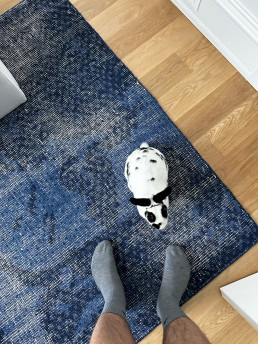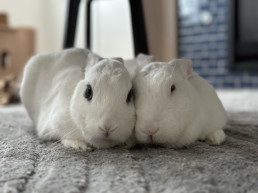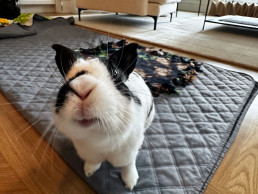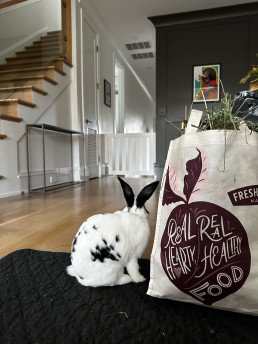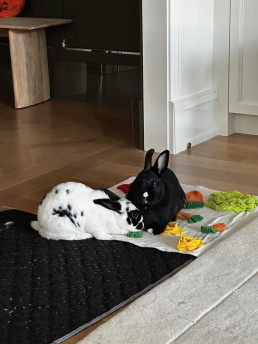Making A Match: Rabbit Pairing Tips
We all know the joy of having a rabbit hopping around the house, checking out the dust balls under the sofa and finding that perfect sunny spot to spend a lazy afternoon. If you think that one rabbit is a perfect companion, just wait until you try two. Companionship is a welfare requirement for social animals like rabbits and we believe no rabbit should be living solo. In fact, it’s illegal in many countries to keep single rabbits. We interview people all the time who are looking to pair their lone rabbits and we hear a number of the same questions and concerns over and over again. There is a lot of confusion and many questions, and we want to try to dispel as much of that confusion and answer as many questions as we can. Here are a few we hear all the time.
If I get a baby bunny for my rabbit her maternal instincts will kick in and she’ll accept the new rabbit easier.
Initially there may be no fighting if you try to pair your bunny with an immature rabbit, but once that baby reaches sexual maturity the adult will likely realize that there is another rabbit in the house and fighting may ensue. This same behavior occurs between siblings when they reach sexual maturity; one day you have a pair of brothers who love to lay around next to one another, and the next you have a fight for dominance. The social hierarchy is thicker than blood in the rabbit world.
I want a cuddly, cute bunny to pair with Thumper. Sometimes the cutest bunnies can be the most feisty and you may find that a less physically attractive rabbit gets along best with your bunny. Human beings have an aesthetic sense that is altogether different than that of our rabbits. It’s always best to let your rabbit choose who they want to live with.
Will my bunny still pay attention to me if I get a companion for her?
This is a real concern, of course. Who would want to find that the bunny who used to come sit beside us willingly is suddenly too busy with her new friend? We try to keep people from looking at the pairing as losing a bunny; what you’re really doing is getting a second little friend. If you spend time with both of the rabbits together, there’s little chance that they’ll become aloof. Sit on the floor with both rabbits, pet them both and give them both the usual treats. There is a tendency to assume that once your rabbit has a companion she won’t need as much attention from you; while this may be true, we often find that once bonded, all rabbits have an improved demeanor because all of their needs are being met. We also often find that “mean” bunnies turn into sweethearts once they have a friend who speaks their language.
Should I get a male or a female?
Sex is completely irrelevant when it comes to bonding. All that matters is that their personalities are compatible.
Will the new bunny teach my rabbit bad habits?
Shortly after a pairing it is possible that litter training will break down for a while as the two new
buddies get used to each other and settle into their new territory together. This is usually only a temporary condition and training tends to come back on its own; it might be necessary to limit their roaming room for a while to help this along, though. We haven’t noticed that one rabbit will teach another behavior like chewing or digging. In fact, many negative behaviors go away once bunnies are bonded because they have constant mental stimulation from their friend. Negative behaviors are most often caused by boredom. After pairing, a docile bunny may become more interested in exploring with the new friend if that new friend happens to be a more adventurous rabbit.
Can the rabbits share space?
Once the rabbits have gone through the bonding process and are fully bonded, they should never be separated.
Rabbits have a tremendously complex social structure, even when the entire society is occupied by only two rabbits. They communicate in ways that we can’t perceive, and it’s important that they be compatible. At the HRS Chicago we take care to make sure that the budding new friendship gets off to a good start: we will try many different rabbits with your bunny to find one who gets along as well as possible, we provide neutral territory for the initial encounter and, most of all, we are always here to help make the pairing work after you’ve taken the new couple home.
Now that you know a little more about rabbit match making, check out our adoptable rabbits and get your bun a companion!
Adopting & Maintaining Bonded Rabbits
Congratulations on adopting your bonded rabbits or on bonding your single rabbits! As you know, rabbits are very social creatures and live happiest with another (neutered) bunny or bunnies. They are also territorial creatures and occasionally bonded bunnies will spat (just like human relationships in which two live very close). The first 6 months or so of a new bond can be especially unstable and you may see your bunnies arguing over small things like new items in their space. Below are some tips to help you understand their behaviors and keep them happy.
- Bonded bunnies should live in a spacious exercise pen that is open topped or a room of their own. They need to have enough room and hidey boxes so they can run into them and de-escalate any spats. Bonded pairs should never live in a closed up cage where there is nowhere to go should one get feisty or upset over something.
Occasional chasing, humping and minor fur pulling is quite normal and redirecting by clapping hands or presenting a treat should be enough to change the mood. Do not separate unless there is biting, circling or boxing. If the latter behaviors happen then you can reduce the size of their living space and remove any items they may be territorial over for a day or two. Spray some Rescue Remedy around their space to help them mellow out. - Exercise in the house is important and they should get at least 4 hours of out-of-pen exercise per day to explore, dance (binky!) and spend time with the family. However with newer bonds, start slow with limited space (maybe one room). TOO MUCH space at one time can overwhelm them and cause them to fight. If this happens with too much space put them in their pen right away where they feel safer and calmer. Let them out at a later time with a more limited area.
- Bonded pairs should ALWAYS travel together in the same carrier. If one has a vet appointment, the other should go along for the ride. Most vets understand this and sometimes, depending on the circumstances and nature of the treatment, most vet hospitals will let the bonded partner stay in the hospital with the other. If not, visitation is usually allowed if the stay is extended. Bring the bonded partner with you for the visit.
- Bonded rabbit pairs use the same litter box and bowls. Make sure the litter box is big enough for them both to fit and move around. They like to eat together and we recommend scatter feeding in general so their food can just be thrown down for them to forage.
- Rabbits grieve very deeply for their bonded partners when they pass away. It’s important to let the surviving rabbit stay with the body for a bit of time for closure. Life after loss will be lonely for the surviving bunny. Provide him/her with a stuffed animal to lean on and groom and work on getting them a new friend as soon as possible.
- It’s rare, but sometimes a bond will completely break. If the bond breaks and you cannot get them back together without them fighting consistently, you should consider starting the bonding process from the beginning.
A note about “spring fever” or weather related hormonal behaviour. It is very common to see some extra hormonal or “aggressive” behaviours with bonded rabbits when the weather starts to warm up. Try not to worry too much about it as long as the bunnies are more or less getting along as usual and there are no actual fights happening. It will eventually pass. If things get too turbulent, you can reduce their living space for a few days and spray some pet remedy around the room to help them chill out.
New Rabbit Checklist
Vet appointment with rabbit savvy vet – the most important thing you can do for your bunny is establish a relationship with a good vet so you’re set up for success in the event of an emergency.
Metal exercise pens or baby gate – Rabbits should have a 10ft x 6ft living space at all times. Two 8 panel exercise pens provide enough space, or you can put a gate in the doorway of a bunny proofed room.
Heavy ceramic bowl – for water! Something big and heavy enough that won’t get tipped or thrown. NEVER use a bottle! They can cause chipped teeth, choking, dehydration, and neck pain.
Hidey house – rabbits should always have a safe spot to hide in their space, preferably one with two entrances
Cat tunnel – rabbits love having tunnels to run through because it mimics how they live in warrens in nature
Basic open litter box – nothing fancy or covered, the bigger the better! They should be able to easily move around in their box to forage for the best hay pieces. We don’t recommend hay racks or bags, as studies show they eat more hay when it’s at ground level.
Rabbit safe litter – wood stove pellets, paper pellets, newspaper, care fresh
Plenty of grass hay – timothy, meadow, orchard, brome, oat, botanical are all good options. Bunnies should NEVER run out of hay. Refresh/top off at least once daily. Expect for some to be wasted every day.
Pellet food – we recommend Oxbow Garden Select, Sherwood & Supreme brand pellets. Pellets should be grass hay based for healthy rabbits. Some seniors or compromised rabbits benefit from an alfalfa based pellet to maintain weight.
Daily mixed greens – aim for a variety every day. Rabbits don’t just eat romaine and cilantro in nature. The more varied their diet, the more resilient they will be to GI upset.
Enrichment toys – bunnies love to chew on wooden toys and fling around plastic baby toys. It keeps them mentally stimulated. If you have a single rabbit and are waiting to adopt a friend for them, we recommend providing them with a bunny sized stuffy to cuddle and groom.
Hard sided carrier – preferably with a door on top for easy handling at the vet. We do not recommend soft sided or backpack style carriers as rabbits like to have their feet firmly on solid ground at all times.
Grooming tools – small cat nail clippers and a hair buster comb are good for your average bunny. You may need electric clippers and dematting tools if you have a wool breed.
Bunny proofing supplies – cord covers, plastic corner protectors, pens to block anything you don’t want chewed
Floor covers – Not all rabbits will make it in the box 100% of the time. If you have carpet you want to preserve, invest in some washable pee pads or rolls of linoleum to cover carpet. Slick flooring should be covered with rugs and blankets to prevent future joint problems. Many rabbit owners really like ruggables for rabbit spaces.
Before You Adopt
Rabbits are not low-maintenance pets
Prepping salads, cleaning the litter box, and providing the attention rabbits need all require time and energy. Bunnies can be messy and will require daily cleaning of their space. A common reason rabbits are abandoned, surrendered or returned is “they’re more work than we expected.”
Rabbits are not great pets for children
Since rabbits enjoy a quiet home and aren’t typically cuddly or attention seeking like cats and dogs, kids lose interest quickly. Another common reason rabbits are abandoned, surrendered or returned is the kids are allergic or the kids got bored.
Rabbits are prey animals so keeping them safe from dogs & cats is important
Rabbits can die of fright at the sound or sight of predators, or from being chased. They’re easily injured because they have very fragile skeletal systems. They generally do not enjoy being handled because they feel as though they’ve been caught by a predator when lifted off the ground.
Rabbits can live 10-15 years (or more!) and need stability in their golden years
Senior bunnies often require specialized care. They can develop chronic conditions like arthritis and kidney disease and may need special accommodations to keep them happy and healthy.
Caring for a rabbit can be quite costly
Due to the specialized care they require, Rabbits can cost $100+/month. They have a specialized diet and can become quite ill if they have a poor diet. Veterinary care, including yearly vaccinations, is generally more costly than for cats and dogs. It can be difficult to find a rabbit savvy vet, even in major cities. Nationwide is the only insurance company that covers rabbits in the US.
Rabbits need space
Contrary to once popular belief, rabbits are not cage animals! You’ll need to have space for a pen, or a room that can be sectioned off for the bunny to live in. The Rabbit Welfare Association recommends access to 10ft x 6ft at all times. They should also stay indoors for their health and safety.
Rabbits can be messy and destructive
Bunnies can be very determined to get into trouble! Any space they have access to should be bunny proofed. Plants should be kept out of the way, cords, corners and trims should be covered and protected.
Rabbits require companionship
Rabbits are social animals and should always have at least one bonded partner. It’s against welfare laws in some countries to keep single rabbits because companionship of their own kind is so important. Bonded bunnies are happier and healthier and are generally LESS work than single bunnies because they can entertain each other and display fewer boredom behaviors. All rabbits must be spayed and neutered before bonding!!!
Adoption Policy
Adoption Process
- The adoption process starts with the prospective adopter submitting an adoption application.
- Once approved, applicants will be interviewed by phone or email by our Foster/Adoption Director.
- If the director(s) and the prospective adopter feel that adoption is right for everyone, the process passes to the foster person if applicable.
- Once an applicant is approved by all directors and foster people, we will schedule a home visit in the adopter’s home to approve housing. Please use our checklist to ensure your home is ready for your new rabbit(s)
- Once housing is approved, single rabbits will come to HRS Chicago for bonding. This takes about a week if the rabbits are compatible.
Our preferred adopter should have 1-2 years of previous house rabbit care experience or have done extensive research on proper care.
Our foster rabbits are in a network of foster homes throughout the Chicagoland area and all directors are volunteers with obligations outside of the rescue. Sometimes it can take a few weeks to coordinate everyone’s schedules for meet & greets. Thank you for your patience.
Adoption Policies
Primary Caregiver. When a rabbit is adopted from HRS Chicago, the primary caregiver must be a responsible adult 25 years of age or older. The rabbit should be treated as an integral part of the family, i.e., no group ownership (such as a classroom pet). We do NOT adopt rabbits as pets for children.
Indoor Housing. Adopters of HRS rabbits must understand that our rabbits are to live as household companions. This means they should not go on excursions outside or into public unless it’s absolutely necessary. No cages or hutches are to be used unless left open 24/7, a 10ftx6ft space should be available at all times.
Social Requirements. We recommend that all rabbits be kept in neutered pairs or groups. Companionship is a welfare requirement 🙂
Neutering and Vaccinating. All resident rabbits must be neutered and current on vaccinations.
Returns. If there are such problems with the adopted rabbit that the adopter needs to return the rabbit, we ask that you give HRS some advance notice. Once an animal is adopted from HRS, the space vacated is usually filled within a week. We will need time to either facilitate an adoption or make space at a foster home. Nevertheless, all rabbits adopted from HRS Chicago must be returned to HRS Chicago in the event the adopter is no longer able to care for them.
Exchanges. HRS does not exchange animals. Exceptions may be made when:
The fosterer and adopter are working together on making a match between an adoptee and a pre-residing rabbit and a different match would be less stressful for the animals.
Adoption fees. HRS Chicago adoption fees are donations that cannot be refunded. We are a federally recognized tax-exempt, nonprofit organization. Donations made to us are no more refundable than they are to any other public charity.
Adopting: A Better Choice Than a Pet Store Purchase
When it comes to bringing a rabbit companion into your life, adopting from a rescue or shelter is a much better option than buying one from a pet store or breeder. This choice not only saves lives but also offers numerous benefits for both you and your new furry friend.
- Saving Lives: Domestic rabbits in shelters and rescues are in need of loving homes. By adopting, you’re giving a second chance to a rabbit that might otherwise face uncertain or unfavorable circumstances. When you adopt from a rescue or shelter, you are also making room for them to save another life. Everyone wins, especially the bunnies.
- Responsible Breeding: There is no such thing as ethical or responsible breeding as long as rabbits are dying in shelters every day due to the overpopulation crisis caused by breeders.
- Health and Socialization: Rabbits from shelters and rescues receive proper health care, socialization, and behavior assessments. Rabbits from reputable rescues are spayed/neutered and vaccinated, which saves you money and reduces the risk of certain health issues.
- Behavior and Temperament: Adopted rabbits typically come with valuable information about their behavior and temperament. This helps you find a rabbit that matches your lifestyle and preferences.
- Rabbits in Need: By adopting, you’re contributing to the well-being of a rabbit in need, rather than supporting a commercial enterprise. It’s a compassionate choice that aligns with the principles of animal welfare and ethical pet guardianship.
- Support for Rescue Organizations: Your adoption fee goes toward the care and rehabilitation of other animals in need. Supporting rescue organizations helps them continue their important work.
- Community and Resources: Reputable shelters and rescues offer valuable resources, guidance, and support to adopters, helping ensure a successful transition for both you and your new rabbit companion.
Adopting your rabbit from a rescue or shelter is the responsible, ethical, and compassionate choice. It not only provides a loving home for a rabbit in need but also promotes responsible pet ownership and helps curb the demand for commercial breeding. If you’re considering adding a rabbit to your family, take the path of adoption to make a positive difference in the lives of these wonderful creatures.

